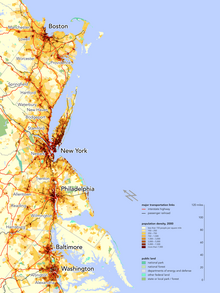This article is missing information about to what degree these predictions did or did not come true. (December 2023) |

BosWash is a name coined by futurist Herman Kahn in a 1967 essay describing a theoretical United States megalopolis extending from the metropolitan area of Boston to that of Washington, D.C.[1] The publication coined terms like BosWash, referring to predicted accretions of the Northeast, and SanSan (San Francisco to San Diego) for the urbanized region in Coastal California. The general concept for the area described by BosWash was first identified (with the name "Megalopolis") as "The Atlantic seaboard area from north of Boston to south of Washington" by French geographer Jean Gottmann in the annual report of the Twentieth Century Fund on May 25, 1958.[2] Gottman elaborated on the 600-mile (970 km) stretch of cities in his 1961 book Megalopolis: The Urbanized Northeastern Seaboard of the United States, although the term BosWash did not appear in the work.[3]
BosNYWash is a variant term that specifically references New York City,[4] which is a central hub and has long been by far the largest metropolis in the region and the country. In 1971, The Bosnywash Megalopolis was published.[5]
- ^ The term BosWash first appeared in a 1967 publication of predictions for the future by the Hudson Institute: Kahn, Herman & Weiner, Anthony (1967). The Year 2000: A Framework for Speculation on the Next Thirty-Three Years. New York: Macmillan. p. 61. ISBN 978-0-02-560440-7.
- ^ "City Chain in East Forming a System—Paris Analyst Calls Coastal 'Megalopolis' the World's 'Largest, Most Complex'", The New York Times, May 26, 1958, p. 32
- ^ Gottmann, Jean (1961). Megalopolis: the Urbanized Northeastern Seaboard of the United States. M.I.T. Press. ISBN 0-527-02819-3.
- ^ Jones, Richard C. (1982). Immigrants outside megalopolis: ethnic transformation in the heartland. Lexington Books. p. 3. ISBN 978-0-7391-1919-8.
- ^ Swatridge, L. A. (1971). The Bosnywash Megalopolis. McGraw-Hill. ISBN 0-07-092795-2.